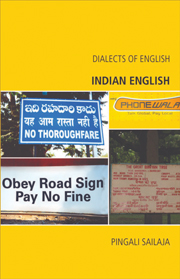Book contents
- Frontmatter
- Contents
- Preface
- Acknowledgements
- Abbreviations, Symbols and other Notational Conventions Used
- 1 Introduction
- 2 Phonetics and Phonology
- 3 Morphosyntax
- 4 Lexis and Discourse
- 5 History and Changes in Progress
- 6 Survey of Previous Work and Annotated Bibliography
- 7 Sample Texts
- Bibliography of Cited Works
- Index
4 - Lexis and Discourse
Published online by Cambridge University Press: 05 August 2013
- Frontmatter
- Contents
- Preface
- Acknowledgements
- Abbreviations, Symbols and other Notational Conventions Used
- 1 Introduction
- 2 Phonetics and Phonology
- 3 Morphosyntax
- 4 Lexis and Discourse
- 5 History and Changes in Progress
- 6 Survey of Previous Work and Annotated Bibliography
- 7 Sample Texts
- Bibliography of Cited Works
- Index
Summary
Lexis of Indian English has been studied to some extent by scholars. Since early times, words that have gone from India to native varieties of English have been of scholarly and general interest. When compared to syntax, the insistence on the use of the standard form is less pressing for lexis. There are definitely words that are considered to be standard and others non-standard, while some are considered to be informal. These are discussed in this chapter. Discourse, as may be expected, draws from features of Indian languages.
Indian English Lexis
There is substantial creativity in Indian English lexis. There are different ways in which the vocabulary of Indian English has been built up. But, before we consider those aspects, it will be useful to do a little comparison with native varieties first and also to look at what constitutes Indian English lexis.
- Type
- Chapter
- Information
- Indian English , pp. 66 - 94Publisher: Edinburgh University PressPrint publication year: 2009

